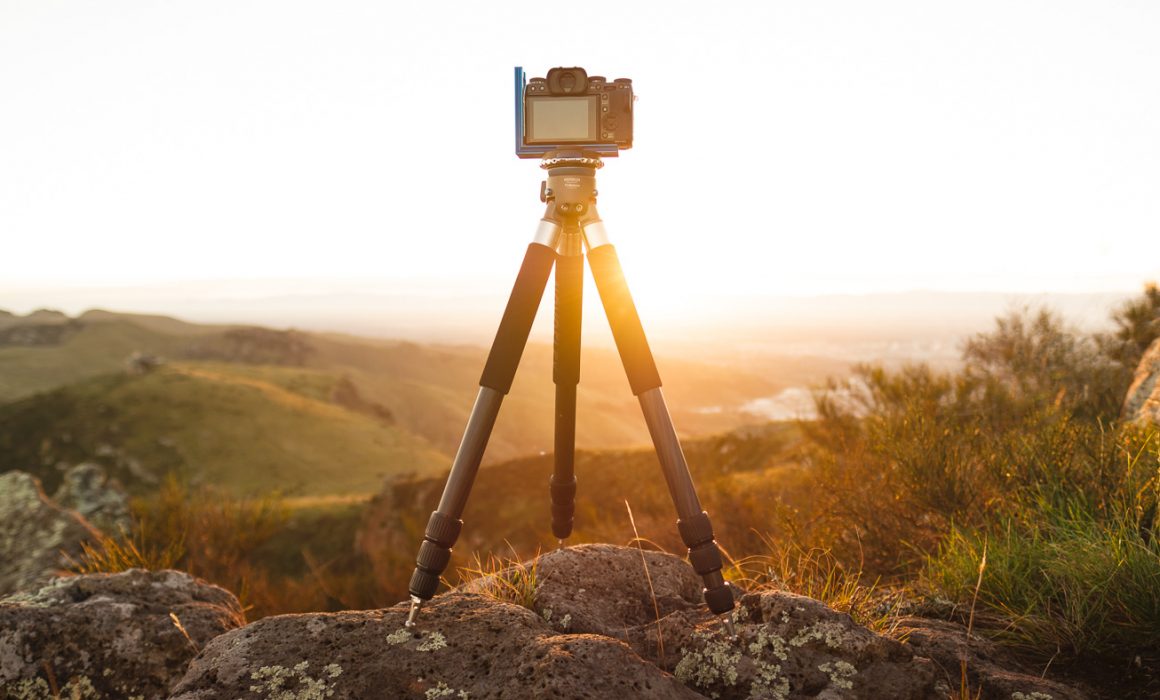Novoflex Triobalance with Q=Base: The last tripod you might ever need
A few years ago I did not get the fuss that some photographers made about tripods. At that point, all I wanted was a stable platform for my camera. I had a reasonably priced aluminium tripod that came up to eye-level. You could even attach a camera to it, so what more could I possibly have wanted?
A little later I found that tripods are like lenses: You are always one short of what you think you need. My affordable jack-of-all-trades tripod was soon replaced by a sturdier version for commercial work. Since it was a bit on the hefty side I decided to add a half-height tripod for camping trips in the mountains to my collection. Did I mention shooting in the ocean yet? Salt water does funny things to a tripod, so I added a waterproof one to my collection. You see where this is going …
For classical landscape photography I wanted a tripod that is stable, full-height when used, compact when collapsed, lightweight and cheap. As with any good Venn-diagram-of-things-you-cannot-have-at-the-same-time, I had to pick my poison. Since I found myself doing increasingly more serious landscape work, I wanted as many of these benefits as possible. Especially when guiding groups, the safety gear was starting to take up so much space in my pack that I was keen to go smaller and lighter without sacrificing stability.
Triobalance
As I was looking for yet another new tripod, Novoflex approached me through their New Zealand distributor Progear. They had enjoyed my recent review of their lightweight panorama system, and were keen to send some goodies my way. What’s not to like? After perusing their product portfolio, I came across the Triobalance series, which really seemed a bit ludicrous at first.
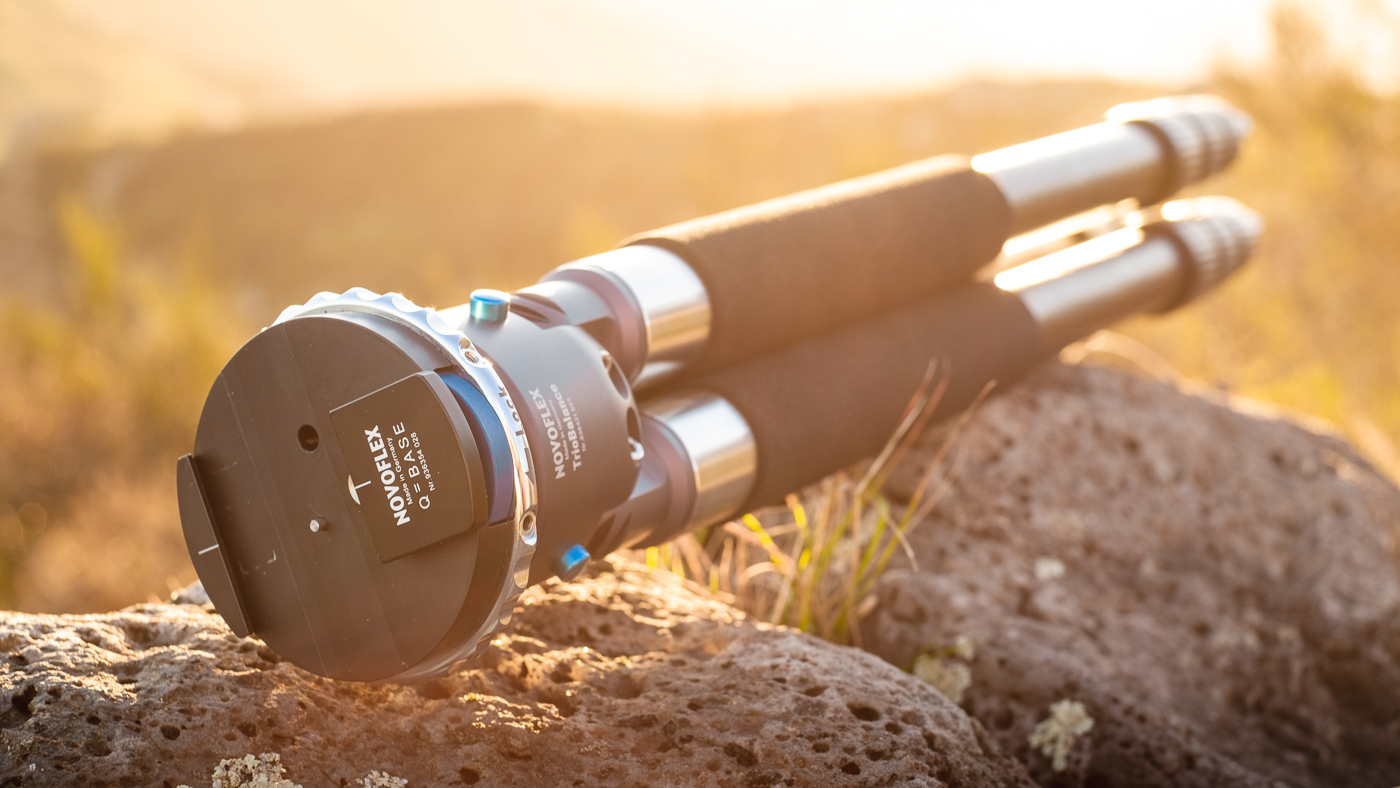
With most tripods you combine a head with legs to have a fully functional tripod. The Triobalance on the other hand comes with a built-in levelling base that can either be used instead of a tripod head or in addition to it. Panorama shooters appreciate how nice it is to have a levelling base.
That made me wonder: Since I exclusively shoot with an L-bracket these days, I did not really need the wide range of motion that most tripod heads offer. What if I just used the built-in levelling base instead?
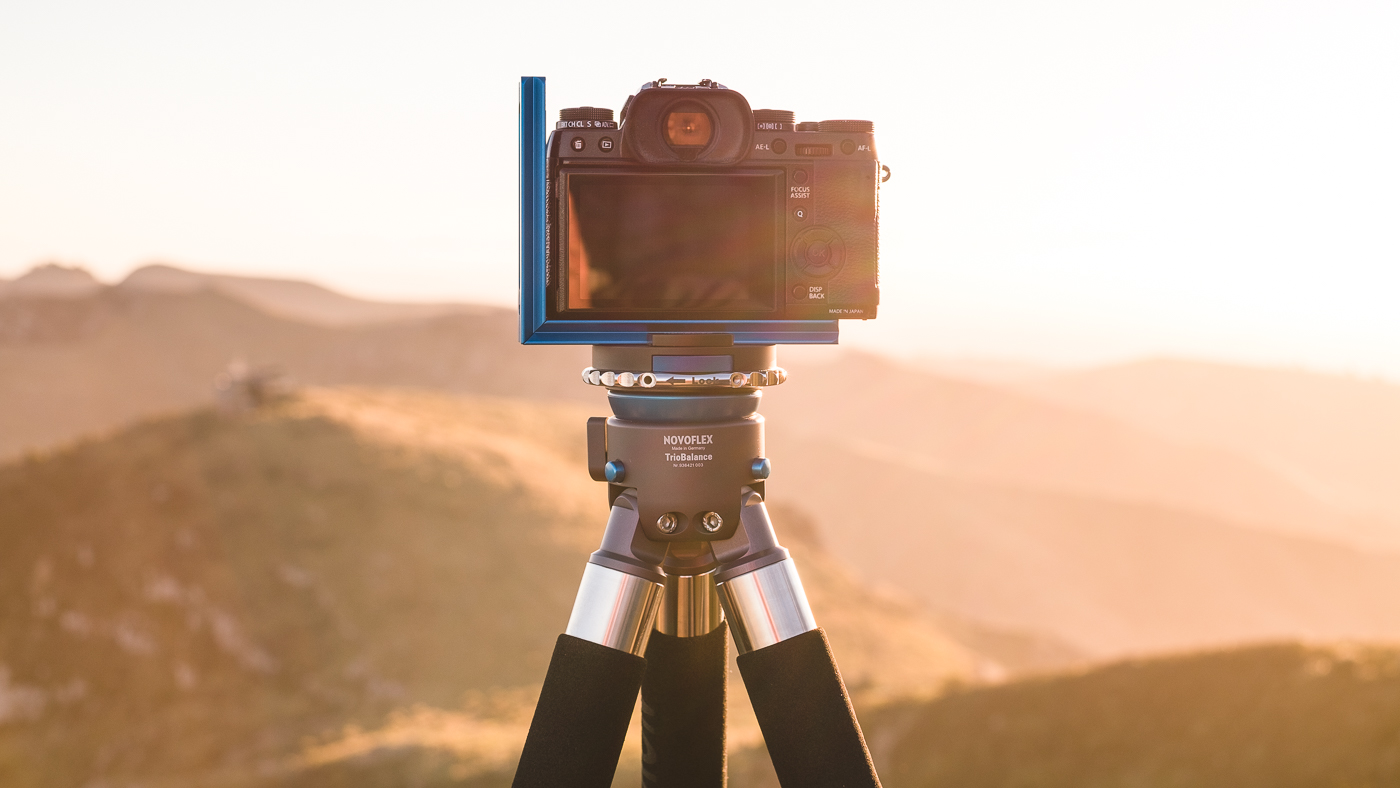
The lack of a centre column as the other absence of a feature. Due to the compact base of the tripod (no gap between folded legs) and the integrated levelling base, there is simply no space for a centre column. While I absolutely need a centre column for my commercial work, I had not used one for my outdoor activities in years. Another few more grams shaved off the total.
Q=Base
That left me in need of a quick release system. While I could have added a standard Arca compatible clamp, I found a quirky QR system called the Q=Base on the Novoflex website. It took a little digging through their Youtube channel to see it in action. The Q=Base is similar to a standard Manfrotto RC2 or RC4 quick release system, except that it works with Arca compatible plates or L-brackets. I had considered Manfrotto’s RC systems in the past, but did not find it very practical to attach two QR plates to my L-bracket.
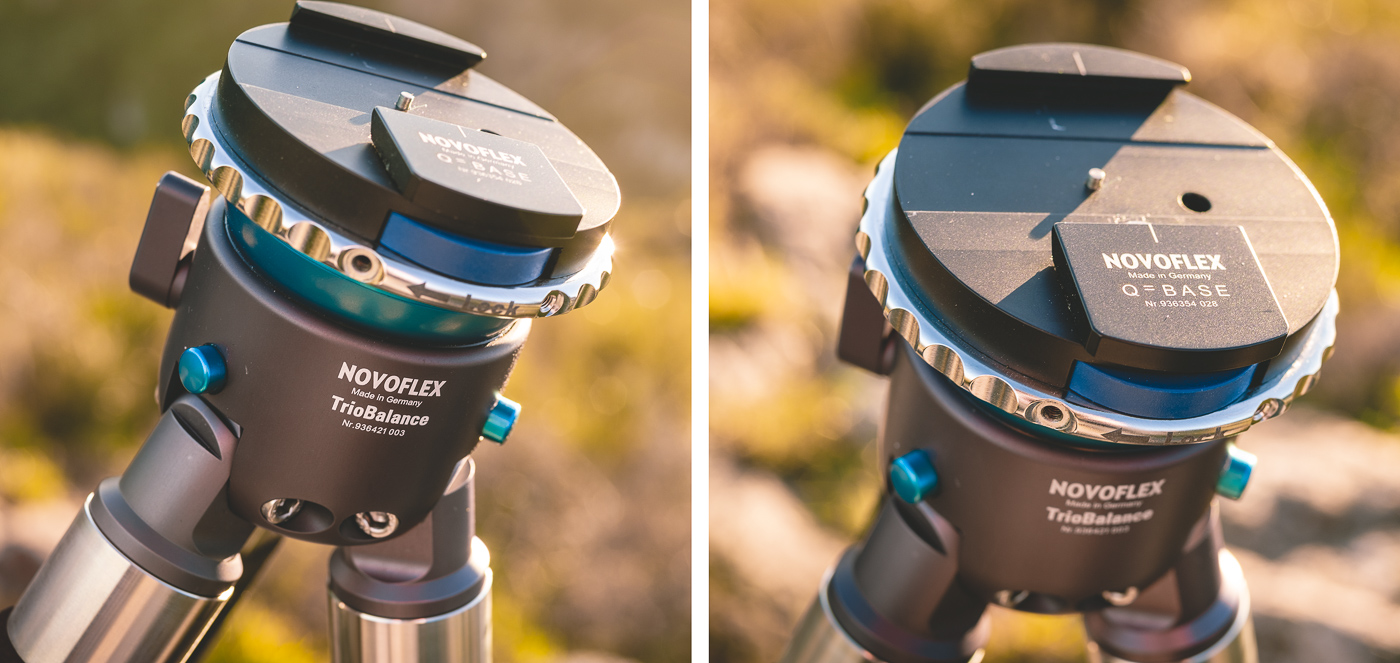
The L-bracket (I’m using the slim L-bracket by Novoflex) just snaps into place when pushed into the mount from above. This can be done with one hand and does not require any interaction with the clamp mechanism. To remove the camera, two buttons need to be pressed to load the spring that triggers the mechanism when clipping back in.
While the Q=Base added some weight compared to a standard clamp, it completely freed me from messing around with knobs. I might just be a bit clumsy, but over the years I had many close calls with knobs that were not tightened sufficiently, cameras not sitting in the clamping mechanism correctly, or movement due to changes in temperature. This happened rarely, but when I was wearing gloves in total darkness and being slightly groggy from an early start, it would happen occasionally. I was hopeful the Q=Base would fix that problem for me.
First Impressions
After a short wait (no stock in New Zealand at the time), I received the kit version (TRIOBALC2840) with four-segment carbon-fibre legs and a ton of accessories. The Q=Base was easily screwed onto the 1/4″ mount on the levelling based and secured in place with a small hex screw.
The thing sitting right before me was a strange beast. It just looked like something important was missing. The lack of a ‘proper’ tripod head removes so many knobs and quite a bit of height that it seemed like I was just looking at a bare set of legs.
Overall finish and build quality are in line with every joke that has ever been made about German engineering. The tripod combines absolute minimalism with perfect build quality. It left me with a strong urge of wanting to touch it, otherwise only experienced with Apple devices. The buttons feel great, everything clicks, slides and rotates the way it should. Here’s a list of other features that stood out to me:
- The best, most over-engineered spikes I’ve ever seen
- Optional rubber caps for the spikes are included
- Foam covers on all three legs keep hands warm
- The legs are removable and can be replaced with other Novoflex legs
- Stubby little legs for tabletop photography are included with the tripod
- Some Leki hiking poles can be converted into tripod legs. How cool is that?
- The top segments of the carbon fibre legs have length markers on them
- The tripod comes with a nice carrying bag
Size & Weight Comparison
Legs
Manfrotto MT057C4
Sirui W2204
Novoflex TriobalC2840
Sirui T-025x
Head
Manfrotto 410
Sirui K20x
Integrated
Sunwayphoto FB-28i
Weight
4880g
2171g
1807g
860g
Collapsed Length
83cm
69cm
58cm
33cm
Extended Length
222cm
157cm
151cm
138cm (very wobbly)
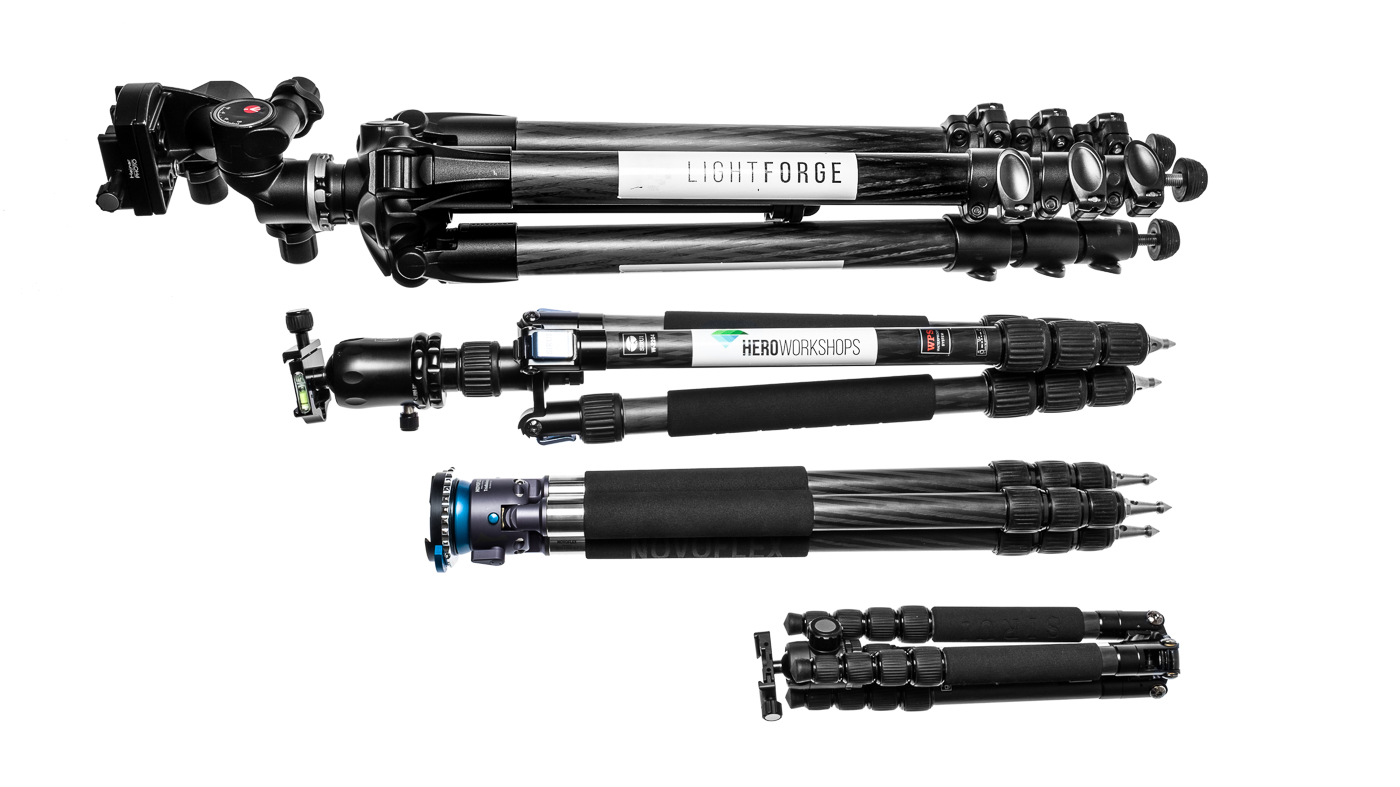
I’m aware that comparing these tripods is ridiculous, but I thought they would give an idea of scale. The Manfrotto 057 is a beast of a tripod. Fully extended a step ladder is required to get to the top. It’s strictly a work tool for shooting over fences or for mounting something the size of a microwave oven. The Sirui W2204 is a normal height landscape photography tripod, and a direct competitor of the Novoflex. The smaller Sirui T-025x is a half-height tripod that falls in the ‘better than nothing’ category. I only use it on overnight hiking trips where low weight beats all other considerations. Full extended it will sway in the wind like a blade of grass.
Setup
Using a tripod starts with packing it. Where all my previous tripods were awkwardly attached to my Frankenpack with one or two legs, the small diameter of the Triobalance allows me to stuff it upside down into a mesh pocket, securing it with a strap. I love using spikes outdoors, and with these I will have to take extra care not to impale anyone. These things are really pointy!
It does not take much to strain my neck, so I appreciated losing around 300g compared to a tripod of equivalent height and stability. It is good to keep in mind that the Q=Base adds a little extra weight. With a standard clamp you can expect to save around 150g, bringing the tripod down to a little over 1550g.
- Triobalance with Q=Base = 1807g
- Triobalance with standard clamp ~ 1650g
- Triobalance without clamp = 1545g
Setting it up is standard: The big rubberized twist-locks unlock with a half-turn. As with most carbon-fibre tripods, the legs need a gentle tug to extend them. I assume this is an engineering trade-off between easily deployable legs and a secure, snug fit that adds torsional stiffness. The legs adjust to four different angles from 20 to 87 degrees.
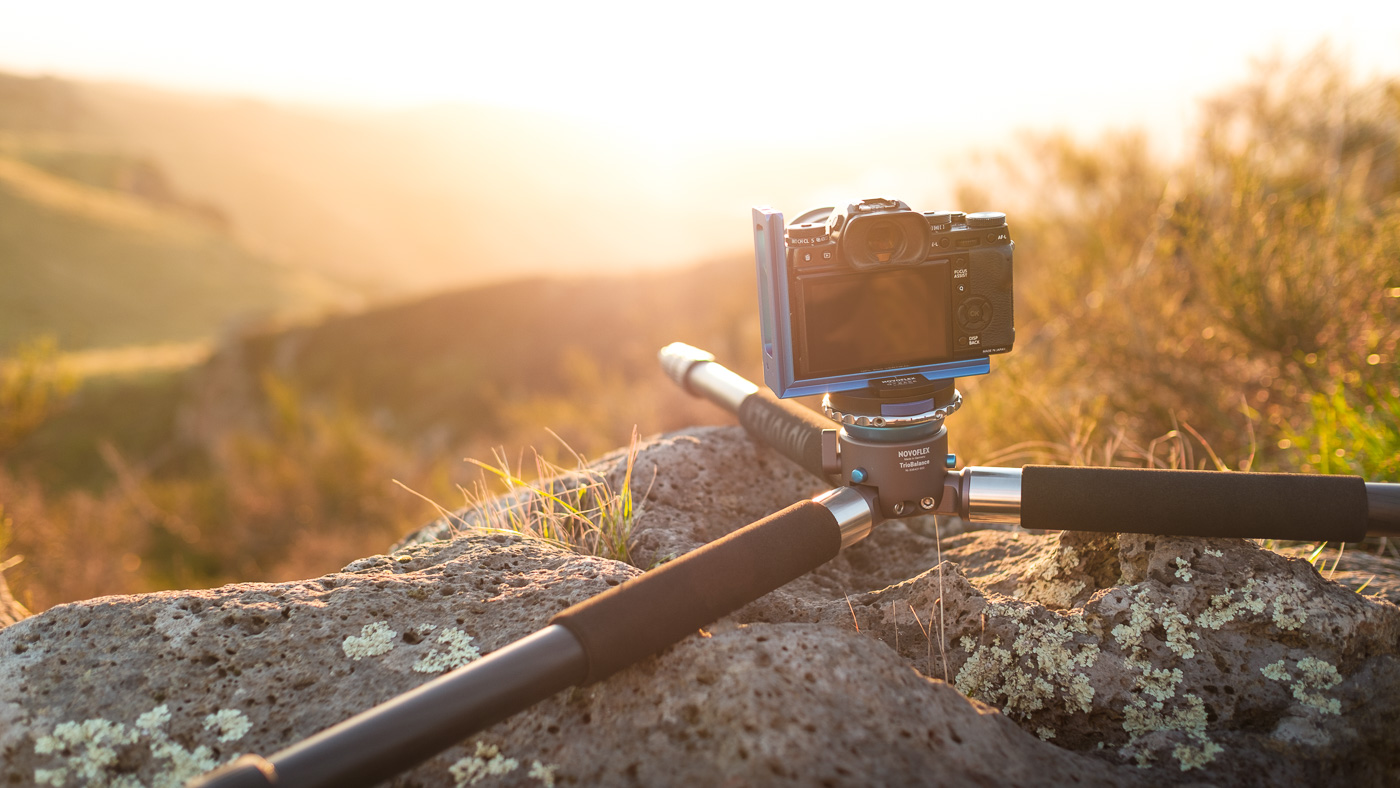
Fully extended, the tripod with spikes and Q=Base comes to a height of 151cm, which is perfect for someone of my height (182cm).
Shooting
Well, it’s a tripod. I found this setup to live up to my requirements when shooting my Fujifilm X-T2. I would not hesitate to use it with a Fujifilm GFX and some of the lighter lenses.
Everything works exactly as advertised, starting at the very bottom. The spikes are ridiculous in a really good way. Where my other spikes had issues properly gripping on rocky terrain, these spikes just dig in. A facetted, spiky ball at the end of a long, thin shaft allows the spikes to dig into the terrain, even when the legs are fully spread out to 87 degrees.
The rubberized locks are easy to operate even in cold conditions with gloves on. A flick of the wrist is usually enough to lock or unlock them. The stripes around the top segment help a lot when trying to set all legs to an equal length when not fully extended. I only wish there was a way to secure the legs into the base. It seems Novoflex favoured easy swapping of legs from one tripod to the other over securely seating them. Too much enthusiasm when loosening the leg segments can unscrew the whole leg from its base. While this doesn’t happen to me often, it can be a little annoying. Since I rarely replace the legs with the included tabletop legs, I’d prefer if there was a way to secure them in place with a hex screw. Maybe a dab of Loctite will help.
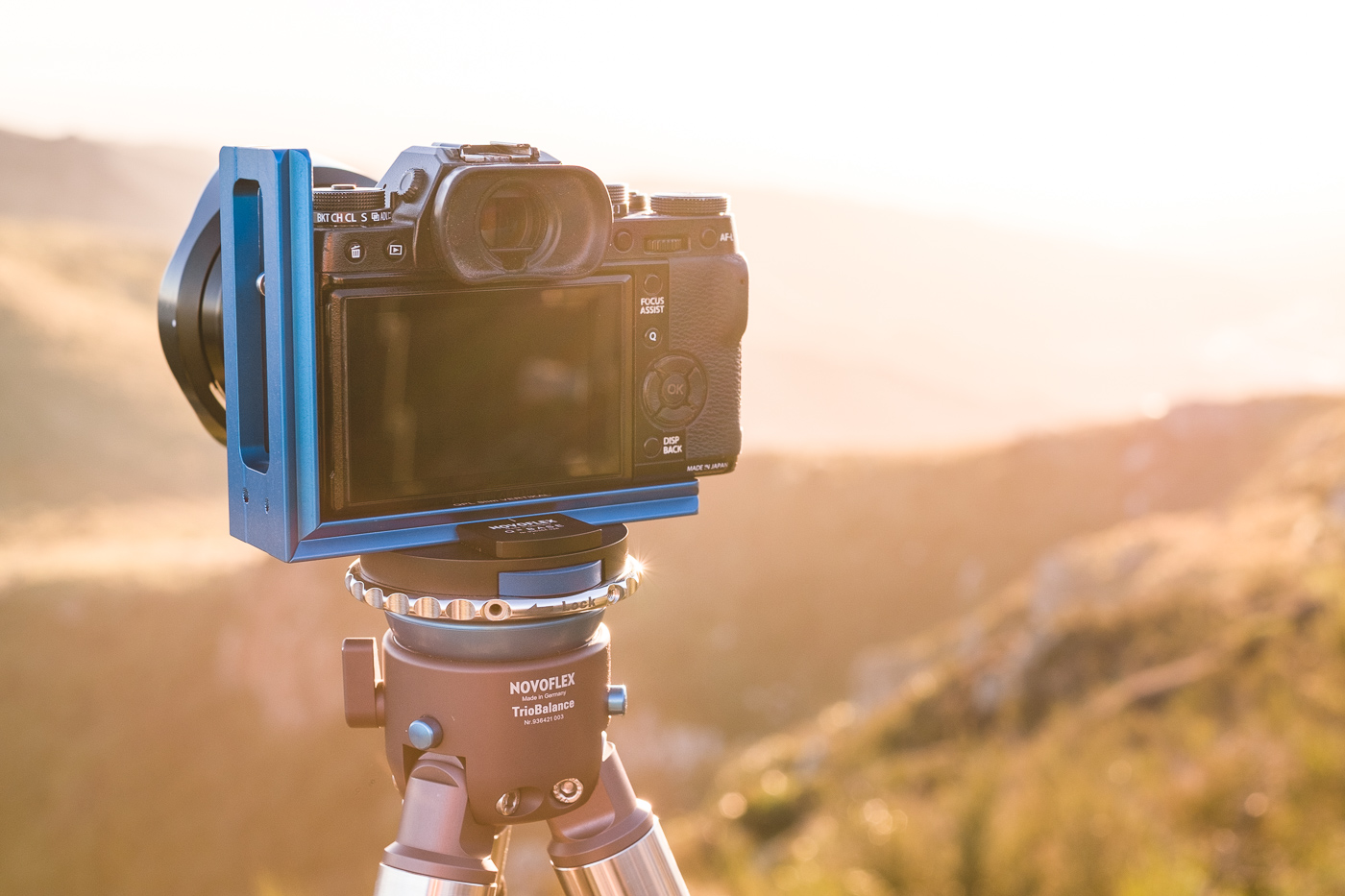
The mechanism to set the leg angle is simplicity itself. The spring loaded button is easy to operate and I will take it over all the awkward latching mechanisms I have come across.
The integrated levelling base is the central element that lends this tripods its uniqueness. It is operated with a simple lever that allows the base to be swivelled and rotated freely. The angle of adjustments is more than sufficient to level the base on any kind of terrain. Precision adjustments are no harder or easier than with a standard ball head. Shooters who are after ultimate precision will have to stick to geared heads and pay the weight penalty. In the opened position, the mechanism is just on the right side of loose. It rotates in its base with silky smoothness.
The Q=Base is the other unique feature of this tripod. I used it combined with Arca Swiss compatible plates and L-brackets by Novoflex, but it should really work with any other brand. Keep in mind that the safety stop feature might not work with other brands (the camera might fall out), and the friction mechanism might have more or less grip than ideal. More on that below.
The ease of operation is totally worth the 150g weight penalty compared to a standard clamp. In the past I had to fiddle with knobs that sometimes weren’t tight enough. In other cases just one flange was gripping the Arca plate thanks to stupid old me. Especially when changing orientation often, the Q=Base is a revelation. The system allows me to simply drop the camera into the clamp with one hand. A clearly audible click will give me positive feedback that the camera is secured.
But that is only the start. Once clicked into position, the camera sits firm enough as to not move by itself. But with just the right amount of gentle pressure it can still be positioned within the clamp. Trust issues? Just rotate the silver ring to lock the bracket for good. I found the locking ring to be a reassuring feature in strong wind or when used with the camera on a boom. In saying that, the effect was purely psychological since the camera can not fall out thanks to the safety stop.
Over time I have come to trust the mechanism implicitly. Remember, the camera does not move unless you deliberately try to do so. If you use the silver ring regularly, you can screw in a little 10mm rod. The extra leverage will make it a easier to operate.
I have since started using another Q=Base on my work tripod. I switch from landscape to portrait format 100+ times during every shoot, and I just love how it saves me time while reducing the risk of dropping the camera. It is really one of these things I would not want to be without any more.
One small caveat with the Q=Base is that it is quite large in diameter. Both buttons have a strong spring built in, and I could see how it might be difficult to use with small hands. You will see me struggling to press the buttons at one point in the video, which was not caused by the mechanism, but by my awkward attempts not to block the video camera. Novoflex could chose to make the buttons a little bigger, but that would result in more weight.
Coming back to the Venn diagram of things we cannot all have at the same time, there are of course some downsides to this system. The smaller base diameter of the legs allows for a more compact build, but at the same time it reduces torsional stiffness. I shoot a Fujifilm X-T2 with and without a panorama head and have not had any issues with the slight reduction in stiffness. A pro-level full-frame camera with a tele zoom or a medium frame camera might perform differently. For heavier cameras I would suggest to go with more traditional tripods like a Novoflex Triopod (Triobalance without the levelling unit), or a Tripod Pro75 (chunkier Triopod with greater base diameter).
Novoflex’ choice of finish for the aluminium elements comes with a drawback: Their products scratch really easily. Given how beautiful their products look fresh out of the box, every little scratch will hurt. Other brands seem to either paint or powder-coat their products, which results in higher weight and a slightly less high-end look, but they are far less susceptible to scratches than anodizing.
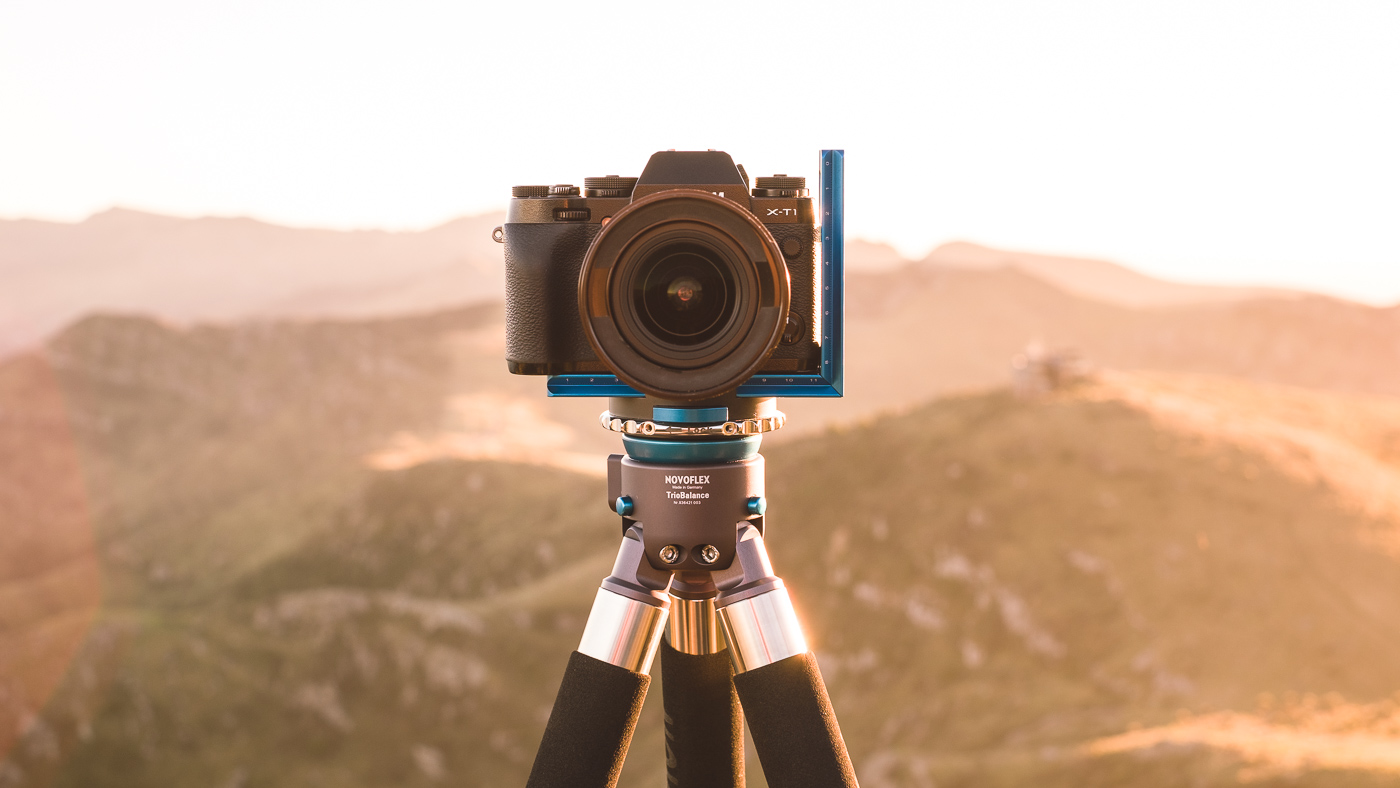
As mentioned above, the low diameter design comes at the expense of additional features like a centre column and a hook for attaching weight. The former is not really a fair criticism of the product, since it’s designed as a minimalist product. The standard Triopod series comes with an optional centre column (with yet another pretty unique design approach). If you need a hook to weigh down your Triobalance, your only option is the ‘triangle supporting pouch’, which I cannot seem to link to. You can find it on their page under accessories.
Options
At the end of the day it is a matter of picking your poison. Do you shoot L-brackets, do not mind the lack of centre-column or hook, and do value low weight and portability over maximum torsional stiffness? Then a Triobalance with Q=Base could be the right landscape tripod for you.
- Need a centre column? A standard Triopod might be the better option. You can still combine it with a levelling base and drop the ball head.
- Heavy camera? Have a look at a Triopod PRO75.
- The levelling base is too limited? Get a standard Triopod with ball head. (Guess what, they have a really funky one!)
- Q=Base too heavy? Drop 150g and get a standard Arca clamp.
Pros & Cons
Pro
Beautiful engineering
Compact
Lightweight
Minimalist
Spikes
Fast and safe quick release system
Lots of accessories included
Lots more accessories to buy
Interchangeability of components with other Novoflex tripods
Con
Lack of torsional stiffness
No centre column
Scratches easily
No hook
Q=Base adds weight
Q=Base might be hard to operate with small hands
L-bracket required to shoot in portrait orientation
Price
Verdict
I was not quite sure what to expect when I received the Triobalance. It just looked like a lot of important bits were missing, and I was not sure if it would be up to the task. After using it for a while, I was able to lay these concerns to rest. The way I configured my Triobalance with Q=Base was a great fit for how I use a landscape tripod. I have been able to trim out all the fat, resulting in a small, lightweight, full-height tripod that does exactly what it is supposed to do, and nothing more.
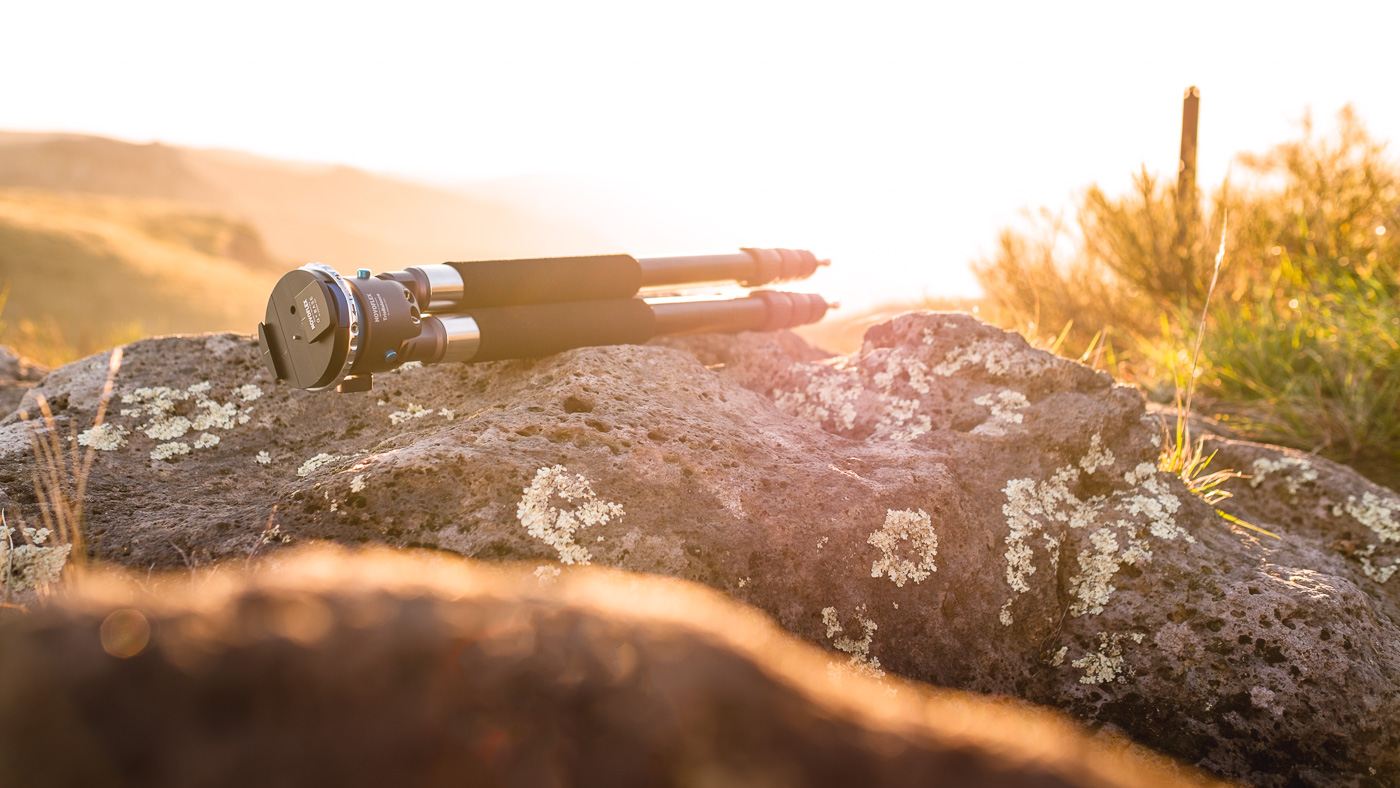
Pairing the tripod with my VR-Slim panorama bracket (see my review) further expands the capabilities of the Triobalance. At 2.5kg you have a fully-fledged multi-row capable panorama system.
Which brings us to the main caveat, the price. This will probably not be the first tripod anyone buys, but for landscapes it might well be the last. The Triobalance is a very specialised beast, but what it does, it does really well.
Resources
Novoflex Website
In New Zealand? Buy one at Progear
Disclaimer
In case you missed it in the introduction: I’m Novoflex’ freshly minted product ambassador in New Zealand. After my recent review of the VR-Slim panorama bracket (that I paid for with my own money), Novoflex approached me, asking if I wanted to work with them. I always liked their products, so I jumped on board!
You are probably wondering if this review can be trusted. I did my best to write an unbiased review, with all the good and bad stuff that I came across. It is up to you to decide if I did a good job. Feel free to leave me your thoughts here.

